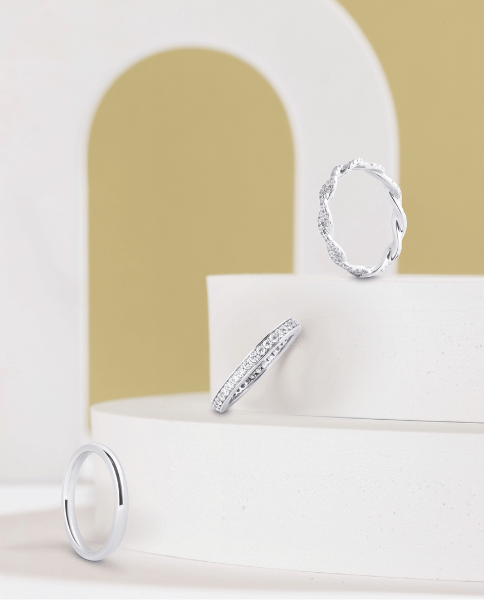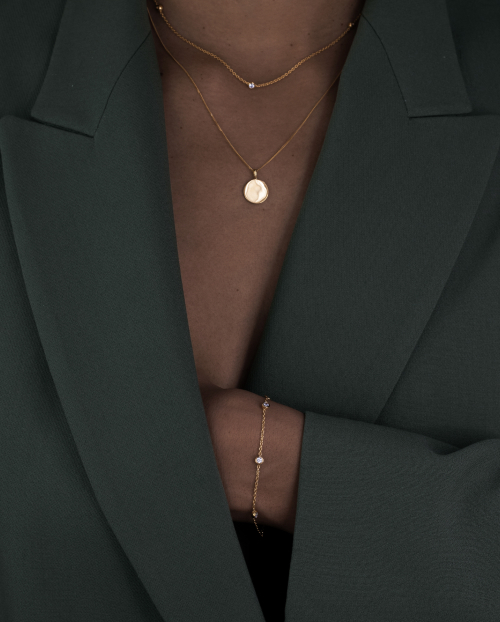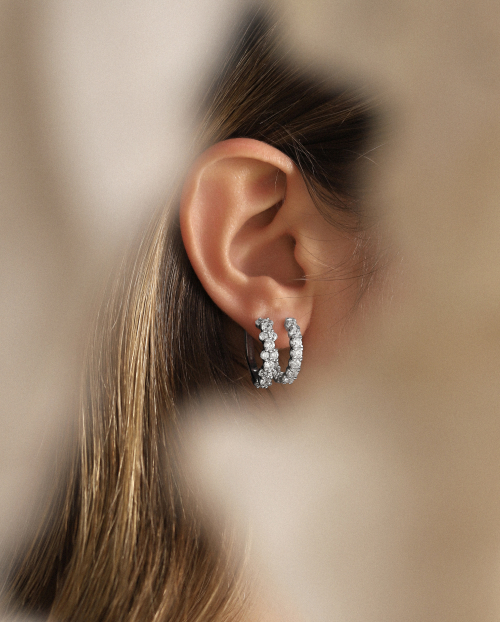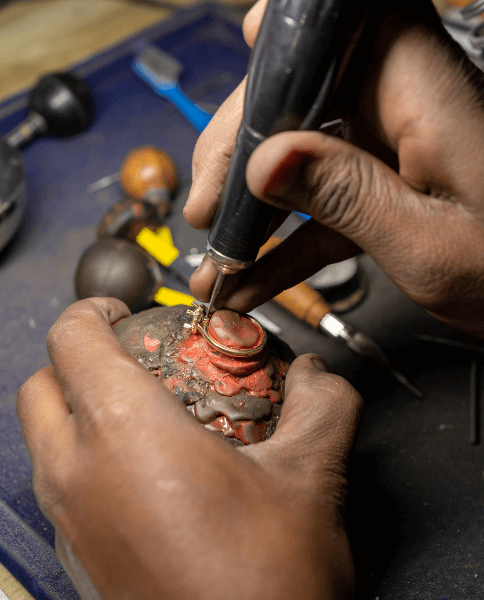Natural Diamonds Vs Synthetic Diamonds
Prized throughout history for their beautiful sparkle, diamonds are also the hardest of all the gemstones. It’s no wonder, then, that they’ve long been a symbol of enduring love. But while diamonds remain the top choice of gemstone for engagement rings, couples can now choose between two different types: natural diamonds and synthetic diamonds.
While they’re chemically identical, there are some key differences between the two when it comes to how they’re made and sourced. In this guide, we’ll compare natural and synthetic diamonds, and delve into the ethical and sustainable advantages of choosing a lab-grown diamond over a natural one.
So, let's get started!
What is a Natural Diamond?
A natural diamond is a mineral made up of pure carbon, with a tiny percentage (less than 1%) of trace elements. It’s the hardest natural material on the earth, thanks to its cubic crystal structure. Natural diamonds are formed when carbon deep under the ground is subject to intense heat and pressure – a process that can take millions, if not billions, of years. They then have to be mined before they are cut and polished and set into jewellery.
What is a Synthetic Diamond?
Synthetic diamonds are exactly the same as natural diamonds in terms of their crystal structure and chemical composition, but they are created in a laboratory as opposed to being formed deep inside the earth.
Methods of Making Synthetic Diamonds
When it comes to creating synthetic diamonds, two popular methods stand out: High Pressure High Temperature (HPHT) & Chemical Vapor Deposition (CVD).
Let’s check in detail.
1. High Pressure, High Temperature (HPHT)
With this process, carbon material is placed in a machine where it undergoes the high pressure and high temperature needed to turn it into a diamond. This technique pretty much mimics the process of creating a natural diamond underground, except that it takes a few weeks as opposed to billions of years.
2. Chemical Vapour Deposition (CVD)
Here, a synthetic diamond “seed” is placed in a vacuum chamber with carbon-containing gases. When the gas molecules break down, carbon crystallises around the seed to create a bigger diamond.
Both these methods offer a more sustainable and ethical alternative to mining for natural diamonds and all the environmental disruption that goes with it.
Importance of Understanding the Disparities between Synthetic and Natural Diamonds
Diamonds have long symbolized luxury and timeless beauty. With the rise of technology, buyers can now choose between natural diamonds, formed deep within the Earth, and synthetic diamonds, created in laboratories. Understanding the differences between these two types is crucial for making informed purchasing decisions.
In the section below, you will get to know the key differences and the similarities between these types of diamonds.
Synthetic Diamonds vs. Natural Diamonds: Know the Difference
Let’s take a closer look at the differences between synthetic and natural diamonds. Here’s how the comparison breaks down:
1. Formation process:
This is perhaps the biggest difference between natural and synthetic diamonds. Natural diamonds are formed by heat and pressure inside the earth while in the case of synthetic diamonds, these conditions are replicated in the lab.
2. Physical properties:
Synthetic and natural diamonds share the same physical properties. They both have cubic crystal structures that give them their signature hardness and wonderful sparkle.
3. Chemical composition:
Chemically, there’s nothing to separate synthetic diamonds from natural ones. Both are made up of pure carbon.
4. Optical properties:
You can’t differentiate synthetic diamond from a natural diamond simply by looking at them. Both types of diamond interact with light to produce the wonderful sparkle that makes them so popular.
5. Purity and inclusions levels:
Every natural diamond is unique and that goes for lab-grown diamonds too. Synthetic diamonds vary in terms of carat, colour, cut and clarity, just like natural diamonds. They contain small inclusions and blemishes that give each diamond its individual character.
6. Pricing and value:
It’s significantly less expensive to produce a diamond in the lab than to extract it from the earth, and this is reflected in the price. Synthetic diamonds are a lot more budget friendly than natural diamonds when you compare diamonds of a similar quality. However, they don’t yet have the same resale value in the longer term due to the rarity of natural diamonds.
7. Durability and hardness:
Because synthetic and natural diamonds have the same structure, they’re exactly the same in terms of durability. Whether you mine it out of the ground or grow it in a lab, a diamond is still the hardest gemstone.
8. Aesthetic appeal:
Synthetic and natural diamonds are visually identical. A lab-grown diamond will sparkle just as brightly on your ring finger as a natural diamond.
9. Environmental impact:
Here’s where the differences really start to show. Natural diamonds come with a whole heap of environmental baggage thanks to a mining process that involves clearing land, eroding soil, polluting water, producing chemicals and generally disrupting the surrounding ecosystem.
Synthetic diamonds use energy in the manufacturing process, but overall this is significantly less harmful to the environment than mining for natural diamonds.
10. Ethical considerations:
While the natural diamond industry has worked hard to improve its practices (for example, by adopting the Kimberley process to eliminate so-called blood diamonds from the supply chain), it’s still impossible to trace an individual diamond back to its original source.
When you work with synthetic diamonds, on the other hand, you can follow them all the way back to the lab where they were made for transparency and true peace of mind.
11. Regulatory framework and certifications:
Both natural diamonds and synthetic diamonds are graded and certified according to the 4Cs: carat, cut, clarity and colour. When you buy synthetic diamond jewellery from Sacet, for example, you’ll receive a certificate from International Gemological Institute (IGI) detailing its quality grades.
12. Market trends:
Demand for synthetic diamonds has been growing, and while the price is certainly a factor, they also appeal to conscious consumers who care about their impact on the environment. Celebrities such as Taylor Swift, Reese Witherspoon and Emma Watson have all been pictured in synthetic diamond jewellery. Here is a table
|
Aspect |
Natural Diamonds |
Synthetic Diamonds |
|
Formation Process |
Formed by heat and pressure inside the earth. |
Conditions of heat and pressure are replicated in the lab. |
|
Properties Physical |
Both have cubic crystal structures that give them their signature hardness and wonderful sparkle. |
Both have cubic crystal structures that give them their signature hardness and wonderful sparkle. |
|
Chemical Composition |
Made up of pure carbon. |
Made up of pure carbon. |
|
Optical Properties |
Interact with light to produce sparkle, visually identical to syntheti diamonds. |
Interact with light to produce sparkle, visually identical to natural diamonds. |
|
Environmental Impact |
Mining process involves environmental disruption, soil erosion, water pollution, and chemical use. |
Uses energy in manufacturing but significantly less harmful to the environment than natural diamond mining. |
|
Ethical Considerations |
Hard to trace back to original source, despite Kimberley process improvements. |
Can be traced back to the lab where they were made, ensuring transparency. |
|
Regulatory Framework and Certifications |
Graded and certified according to the 4Cs, certification provided (e.g., by IGI). |
Graded and certified according to the 4Cs, certification provided (e.g., by IGI). |
|
Market Trends |
Valued for rarity, traditional appeal. |
Growing demand due to cost-effectiveness and environmental considerations; popular among conscious consumers. |
|
Benefits of Buying |
Valued for rarity and traditional appeal. |
Kinder to the environment, more cost-effective, identical to natural diamonds. |
Are Lab Diamonds the Same as Synthetic Diamonds?
Yes, “lab diamonds” is simply another term for synthetic diamonds, and both terms can be used to refer to diamonds manufactured using the HPHT or CVD methods.
However, while lab diamonds and synthetic diamonds are interchangeable, you can’t say the same about “simulated diamonds”. These are gemstones that look similar to diamonds, but don’t share the same structure or composition. Cubic zirconia and moissanite are both examples of simulated diamonds.
Choose Your Perfect Diamond Jewellery with Sacet
In summary, natural diamonds and synthetic diamonds are chemically, physically and visually identical, but the way they’re formed makes all the difference. If you’re seeking sustainable, ethically sourced diamond jewellery, synthetic diamonds are the conscious choice. Synthetic diamonds are graded according to the 4Cs, just like natural diamonds, and are certified in the same way to help you make an informed decision.
At Sacet, we only work with synthetic diamonds, and we use our expertise to source the finest diamonds from the best laboratories in the world. This allows us to create beautiful fine jewellery at a fair price, and to make a positive impact with every piece.
FAQs
1) Are synthetic diamonds more environmentally friendly than natural diamonds?
Yes, synthetic diamonds are more environmentally friendly than natural diamonds. That’s because they’re produced in a laboratory as opposed to being mined. Diamond mining involves clearing land and disturbing fragile ecosystems, as well as causing deforestation, soil erosion, and the release of harmful chemicals into the environment. Even taking into account the energy used to create lab-grown diamonds, synthetic diamonds are the more environmentally conscious choice.
2) Are synthetic diamonds considered "fake" or "imitation" diamonds?
While you might have heard synthetic diamonds referred to as “fake” or “imitation”, this is a misconception. There’s nothing fake about synthetic diamonds – in fact, they’re visually identical to natural diamonds and share the same physical properties and chemical composition as natural diamonds.Synthetic diamonds should be considered “real” diamonds; the only difference is that synthetic diamonds are grown in a laboratory, whereas natural diamonds are mined from the earth.
3) Do synthetic diamonds generally cost less than natural diamonds?
Yes, synthetic diamonds are generally less expensive than natural diamonds. A lab-grown diamond will cost less than a natural diamond with the same quality grading in terms of clarity, carat, colour and cut.

















































